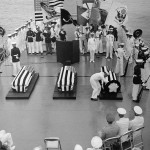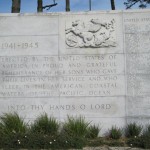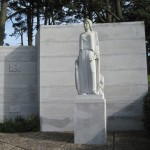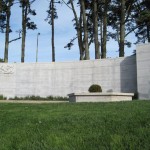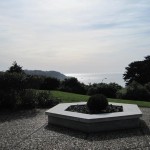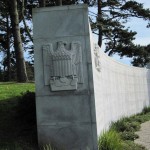Archive for May, 2010
On this Memorial Day it seems an appropriate time to share the story of the selection of the WWII Unknown Soldier – and of the burial at sea of another WWII unknown soldier.
The Unknown Soldier of WWII was not selected until 1958. Nineteen bodies of unknown American soldiers (thirteen from the European Theater of Operations and six from the Pacific Theater) were exhumed from cemeteries in Europe, Africa, the Philippines and Hawaii. All nineteen remains were placed in identical caskets. The European unknowns were shipped to the U.S. cemetery in Epinal, France. The Pacific unknowns were shipped to Hickam Air Force Base, Hawaii. One set of remains was selected from each Theater of Operation – the European unknown selected by an Army General and the Pacific unknown by an Air Force Colonel. The remains not selected were reburied in France and Hawaii. The two caskets remaining were eventually transferred to the U.S.S. Canberra, a guided-missle frigate resting outside the Virginia Capes, along with the Unknown Soldier of the Korean War, also selected in Hawaii from four unknowns from that conflict. Three morticians aboard the Canberra took turns changing the positions of the caskets of the WWII dead, each time alone in a closed space, in total secrecy. The Korean War Unknown Soldier was then placed on the deck of the Canberra, with the two remaining WWII unknowns placed on each side. To quote the official Arlington Cemetery account:
“Navy Hospitalman 1st Class William R. Charette, then the Navy’s only active-duty Medal of Honor recipient, selected the Unknown Soldier of World War II. The remaining casket received a solemn burial at sea.
It’s almost hard to comprehend the journey of the American soldier who was buried at sea from the U.S.S. Canberra that day. It has to be one of the strangest journeys to a final resting place in history. One can only contemplate the endless mystery. Where was he born and raised – the Kansas prairie, the Bronx, the Maine coast, the Arizona desert – or was he an immigrant from Naples or Dublin or Manila? Did he die at Normandy, Guadalcanal, Peleliu, or over the skies of Germany? Was he once buried next to his close comrades and his friends – or was he originally buried in a grave next to no one he ever knew? One thing is probably certain, however, the very instant before he died he never expected to be buried alone at sea off the Virginia Capes more than a decade later.
Navy Hospitalman 1st Class William R. Charette selects the Unknown Soldier of WWII on the deck of the U.S.S. Canberra (May 1958). The center casket contains the remains of the Korean War Unknown Soldier. The casket on the left would be buried at sea off the Virginia Capes.
Additional information on the selection of the WWII Unknown Soldier can be found at these two fascinating websites:
http://www.arlingtoncemetery.org/visitor_information/tomb_of_the_unknowns.html
http://www.arlingtoncemetery.net/unk-w2ko.htm
Maintained by the American Battle Monuments Commission, the World War II West Coast Memorial is located at the intersection of Lincoln and Harrison Boulevards in the Presidio of San Francisco. The site overlooks the area just west of the Pacific Ocean entrance to the Golden Gate Bridge, set above a quiet and winding road that hugs the coast. The memorial can be accessed by car, bicycle, or walking. Several parking places are hidden above the actual memorial.
The curved granite wall lists the names of 412 soldiers, sailors, marines, airmen, and coast guardsman who met their deaths in the Pacific coastal waters of the United States, and whose remains were never recovered or identified. The inscriptions include the name, rank, service branch and State of each of these missing Americans.
Designed by Jean de Marco, the memorial won the 1965 Henry Hering award. Despite the award, it is not one of my favorite memorial designs. It seems to lack a feel for the dangers faced by those serving at sea – there isn’t any sense of drama within the design. I suspect the best time to visit might be on a stormy winter’s day, when the wind and rain and cold would give one a sense of foreboding while gazing at the Pacific. That would be an appropriate time to contemplate the 412 names engraved in gray granite, forever facing the sea where they died.
Welcome to Lost at Sea Memorials.
For ten years of my professional life I was an air traffic controller. One question always asked of a pilot when filing a flight plan is “How many souls on board?” It is a somewhat morbid question. I suspect that ‘souls’ was substituted for ‘bodies’ decades ago, to make it softer in some way. Fortunately that information is seldom needed – and quickly deleted with the flight plan when the flight lands safely.
Lost at Sea Memorials are always dedicated to ‘souls on board’ – souls lost at sea while sailing on naval & merchant marine vessels at war, while flying on aircraft that crash at sea, while manning fishing vessels and research ships and oil derricks lost to accidents and weather. Lives are suddenly and violently lost. Mortal remains are never found. Grateful nations, local associations, labor unions, or families and friends eventually create monuments to these souls.
This blog is devoted to those memorials – and to the lives and the stories they represent. It is my hope that others around the world will add to the site as time passes. Many of these memorials are local in nature – and local residents can best tell their history.
Please send me an email via the ‘Contact’ form if you wish to make a contribution to the site content.
